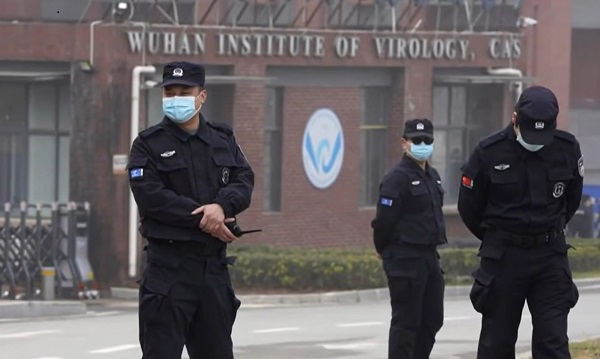Daily Caller
‘A Tough Place To Do Business’: Chevron Exec Details Company’s Decision To Move HQ Out Of California

 From the Daily Caller News Foundation
From the Daily Caller News Foundation
By Nick Pope
A top Chevron executive detailed his company’s decision to move its headquarters out of California in a Thursday roundtable with reporters.
Andy Walz, president of Chevron Americas products, said that California’s crusade against conventional energy producers played a role in the company’s decision to move its headquarters to Texas. Measures like California’s 2035 ban on internal combustion engine vehicles and its emissions cap-and-trade rules were specific headwinds that played a role in the company’s decision to move its headquarters to Houston, Walz said.
“It is a difficult place to do business. It’s a difficult place to be headquartered. And we finally said, ‘Hey, that’s enough. We’ve got critical mass, we’re gonna move.’ We’re also going to improve our performance by getting everybody in the same location,” Walz explained.
Walz made clear that part of the reason for Chevron’s headquarters relocation is that parts of its operations and senior leadership have already been stationed in Texas, and that the company believes its performance can improve if employees and executives are in the same place. The company is not walking away from its assets in California, andChevron plans to continue operating them into the future, Walz said.
“California is a tough place to do business. It’s a tough place to recruit people. It’s a tough place to move employees. A lot of our employees move up through the company, they gain experiences in different geographies, different locations, and we have a lot of people that will not move to California. That makes it difficult,” Walz said. “California is a tough place to have a big employee base. It’s tough, its cost of living is expensive, and we were not able to get employees that didn’t live there to move there. And that’s not sustainable for us, to be honest.”
California has the third-highest cost of living of all states, trailing only Hawaii and Massachusetts, Forbes Magazine assessed in July. Overall, California has seen net outflows of population in recent years, with more than 800,000 people moving out of the state in 2022 alone, according to Forbes.
Additionally, more than 350 companies moved their headquarters out of the state between 2018 and 2022, according to Forbes.
“California has said, ‘Hey, you cannot buy a new car that has an internal combustion engine in it after 2035.’ So, that’s a headwind against investing in a refinery. On the books, they have a windfall profits tax or penalty, they’re evaluating how to deal with that, they want to cap the amount of profits you can make in your refinery. That is a headwind for anybody that would want to put money into it to try to get a return on their investment,” Walz said. “And the third thing that maybe is even a bit more crippling is this: they have a program called cap and trade, where they tax your CO2 emissions in the state of California. And that tax continues to go up every year, and it gets more burdensome every single year. So those three regulations, those three policies, really make it hard for me to want to put more capital into the state of California. Therefore, I think the business case there is really challenging.”
“Our competitors are looking at the exact same equation I’m looking at, and our money is going other places, and California can’t get supplied from Houston,” Walz said. “It doesn’t work.”
The Environmental Protection Agency’s (EPA) recently-finalized tailpipe emissions standards for light- and medium-duty vehicles — which have been characterized by critics as an “EV mandate” — are another policy that Walz believes will have “consequences” if implemented.
Walz’s comments on the business environment in California echo Chevron CEO Mike Wirth’s recent remarks to The Wall Street Journal, in which he said that “California has a number of policies that raise costs, that hurt consumers.”
As news of Chevron’s headquarters relocation broke earlier in August, the office of Democratic California Gov. Gavin Newsom told the Daily Caller News Foundation that the company’s decision was the “logical culmination of a long process that has repeatedly been foreshadowed by Chevron.”
Business
Ted Cruz, Jim Jordan Ramp Up Pressure On Google Parent Company To Deal With ‘Censorship’

From the Daily Caller News Foundation
By Andi Shae Napier
Republican Texas Sen. Ted Cruz and Republican Ohio Rep. Jim Jordan are turning their attention to Google over concerns that the tech giant is censoring users and infringing on Americans’ free speech rights.
Google’s parent company Alphabet, which also owns YouTube, appears to be the GOP’s next Big Tech target. Lawmakers seem to be turning their attention to Alphabet after Mark Zuckerberg’s Meta ended its controversial fact-checking program in favor of a Community Notes system similar to the one used by Elon Musk’s X.
Cruz recently informed reporters of his and fellow senators’ plans to protect free speech.
Dear Readers:
As a nonprofit, we are dependent on the generosity of our readers.
Please consider making a small donation of any amount here. Thank you!
“Stopping online censorship is a major priority for the Commerce Committee,” Cruz said, as reported by Politico. “And we are going to utilize every point of leverage we have to protect free speech online.”
Following his meeting with Alphabet CEO Sundar Pichai last month, Cruz told the outlet, “Big Tech censorship was the single most important topic.”
Jordan, Chairman of the House Judiciary Committee, sent subpoenas to Alphabet and other tech giants such as Rumble, TikTok and Apple in February regarding “compliance with foreign censorship laws, regulations, judicial orders, or other government-initiated efforts” with the intent to discover how foreign governments, or the Biden administration, have limited Americans’ access to free speech.
“Throughout the previous Congress, the Committee expressed concern over YouTube’s censorship of conservatives and political speech,” Jordan wrote in a letter to Pichai in March. “To develop effective legislation, such as the possible enactment of new statutory limits on the executive branch’s ability to work with Big Tech to restrict the circulation of content and deplatform users, the Committee must first understand how and to what extent the executive branch coerced and colluded with companies and other intermediaries to censor speech.”
Jordan subpoenaed tech CEOs in 2023 as well, including Satya Nadella of Microsoft, Tim Cook of Apple and Pichai, among others.
Despite the recent action against the tech giant, the battle stretches back to President Donald Trump’s first administration. Cruz began his investigation of Google in 2019 when he questioned Karan Bhatia, the company’s Vice President for Government Affairs & Public Policy at the time, in a Senate Judiciary Committee hearing. Cruz brought forth a presentation suggesting tech companies, including Google, were straying from free speech and leaning towards censorship.
Even during Congress’ recess, pressure on Google continues to mount as a federal court ruled Thursday that Google’s ad-tech unit violates U.S. antitrust laws and creates an illegal monopoly. This marks the second antitrust ruling against the tech giant as a different court ruled in 2024 that Google abused its dominance of the online search market.
Daily Caller
Daily Caller EXCLUSIVE: Trump’s Broad Ban On Risky Gain-Of-Function Research Nears Completion


From the Daily Caller News Foundation
By Emily Kopp
President Donald Trump could sign a sweeping executive order banning gain-of-function research — research that makes viruses more dangerous in the lab — as soon as May 6, according to a source who has worked with the National Security Council on the issue.
The executive order will take a broad strokes approach, banning research amplifying the infectivity or pathogenicity of any virulent and replicable pathogen, according to the source, who requested anonymity to speak candidly about the anticipated executive action. But significant unresolved issues remain, according to the source, including whether violators will be subject to criminal penalties as bioweaponeers.
The executive order is being steered by Gerald Parker, head of the White House Office of Pandemic Preparedness and Response Policy, which has been incorporated into the NSC. Parker did not respond to requests for comment.
Dear Readers:
As a nonprofit, we are dependent on the generosity of our readers.
Please consider making a small donation of any amount here. Thank you!
In the process of drafting the executive order, Parker has frozen out the federal agencies that have for years championed gain-of-function research and staved off regulation — chiefly Anthony Fauci’s former institute, the National Institute of Allergy and Infectious Diseases at the National Institutes of Health.
The latest policy guidance on gain-of-function research, unveiled under the Biden administration in 2024, was previously expected to go into effect May 6. According to a March 25 letter cosigned by the American Society for Microbiology, the Association for Biosafety and Biosecurity International, and Council on Governmental Relations, organizations that conduct pathogen research have not received direction from the NIH on that guidance — suggesting the executive order would supersede the May 6 deadline.
The 2024 guidance altered the scope of experiments subject to more rigorous review, but charged researchers, universities and funding agencies like NIH with its implementation, which critics say disincentivizes reporting. Many scientists say that researchers and NIH should not be the primary entities conducting cost–benefit analyses of pandemic virus studies.
Parker previously served as the head of the National Science Advisory Board for Biosecurity (NSABB), a group of outside experts that advises NIH on biosecurity matters, and in that role recommended that Congress stand up a new government agency to advise on gain-of-function research. Former Centers for Disease Control and Prevention Director Robert Redfield has also endorsed moving gain-of-function research decision making out of the NIH to an independent commission.
“Given the well documented lapses in the NIH review process, policymakers should … remove final approval of any gain-of function research grants from NIH,” Redfield said in a February op-ed.
It remains to be seen whether the executive order will articulate carveouts for gain-of-function research without risks of harm such as research on non-replicative pseudoviruses, which can be used to study viral evolution without generating pandemic viruses.
It also remains to be seen whether the executive order will define “gain-of-function research” tightly enough to stand up to legal scrutiny should a violator be charged with a crime.
Risky research on coronaviruses funded by the NIH at the Wuhan Institute of Virology through the U.S. nonprofit EcoHealth Alliance typifies the loopholes in NIH’s existing regulatory framework, some biosecurity experts say.
Documents obtained through the Freedom of Information Act in 2023 indicated that EcoHealth Alliance President Peter Daszak submitted a proposal to the Pentagon in 2018 called “DEFUSE” describing gain-of-function experiments on viruses similar to SARS-CoV-2 but downplayed to his intended funder the fact that many of the tests would occur in Wuhan, China.
Daszak and EcoHealth were both debarred from federal funding in January 2025 but have faced no criminal charges.
“I don’t know that criminal penalties are necessary. But we do need more sticks in biosafety as well as carrots,” said a biosecurity expert who requested anonymity to avoid retribution from his employer for weighing in on the expected policy. “For instance, biosafety should be a part of tenure review and whether you get funding for future work.”
Some experts say that it is likely that the COVID-19 crisis was a lab-generated pandemic, and that without major policy changes it might not be the last one.
“Gain-of-function research on potential pandemic pathogens caused the COVID-19 pandemic, killing 20 million and costing $25 trillion,” said Richard Ebright, a Rutgers University microbiologist and longtime critic of high-risk virology, to the Daily Caller News Foundation. “If not stopped, gain-of-function research on potential pandemic pathogens likely will cause future lab-generated pandemics.”
-

 2025 Federal Election1 day ago
2025 Federal Election1 day agoStudy links B.C.’s drug policies to more overdoses, but researchers urge caution
-

 2025 Federal Election2 days ago
2025 Federal Election2 days agoConservatives promise to ban firing of Canadian federal workers based on COVID jab status
-

 International2 days ago
International2 days agoPope Francis Got Canadian History Wrong
-

 2025 Federal Election1 day ago
2025 Federal Election1 day agoCarney’s Hidden Climate Finance Agenda
-

 2025 Federal Election1 day ago
2025 Federal Election1 day agoWhen it comes to pipelines, Carney’s words flow both ways
-

 Business1 day ago
Business1 day agoIs Government Inflation Reporting Accurate?
-

 Environment2 days ago
Environment2 days agoExperiments to dim sunlight will soon be approved by UK government: report
-

 Censorship Industrial Complex2 days ago
Censorship Industrial Complex2 days agoIs free speech over in the UK? Government censorship reaches frightening new levels






